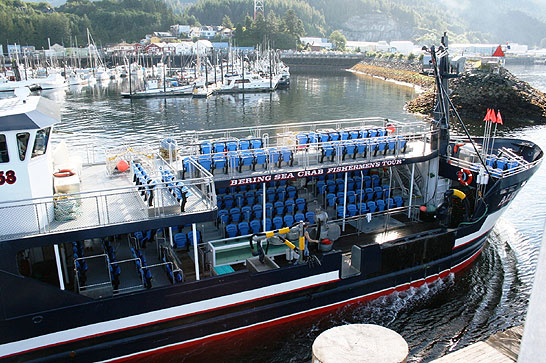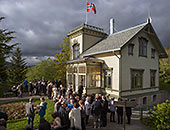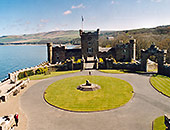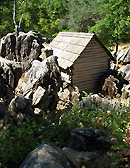|
 inters
in Seattle can be a hellacious ordeal. You come home from work on a
cold, dark, rainy day, and then stare out your window to an even colder,
darker, rainier night. Great. As your mind submerges into the cold waters
of the reality that you are stuck in this room again, for like the 90th
evening in a row, your windpipe tightens. You feel your throat take
a large involuntary gulp, and your eyes widen on their own as you realize
you are going nowhere tonight, yet again, as usual. Glancing over at
your TV, you wonder where exactly it is you will escape to this particular
evening. Believe me, there is nowhere else to go. inters
in Seattle can be a hellacious ordeal. You come home from work on a
cold, dark, rainy day, and then stare out your window to an even colder,
darker, rainier night. Great. As your mind submerges into the cold waters
of the reality that you are stuck in this room again, for like the 90th
evening in a row, your windpipe tightens. You feel your throat take
a large involuntary gulp, and your eyes widen on their own as you realize
you are going nowhere tonight, yet again, as usual. Glancing over at
your TV, you wonder where exactly it is you will escape to this particular
evening. Believe me, there is nowhere else to go.
For the last two winters, I have found a TV show in which I can take
a great deal of comfort in watching others suffer even more miserably
than myself on a nightly basis. This treat to my weary eyes was found
on the amazing Discovery Channel series "Deadliest Catch,"
a show that chronicles the lives of crab fisherman in the Bering Sea.
Day and night, these fish slayers toil in the frigid, wet, super nasty
conditions in one of the most dangerous stretches of water in the world,
a place where things are so overwhelmingly difficult and surreal, one
deckhand described it this way: "Time doesn't exist out here. Time
is a grey line."
Perfect. That's my kind of show entirely on a bleak winter's night here
in Seattle. Many, many nights the last couple of Dark Seasons were spent
obsessively staring into the TV this way, like that freaky kid on the
Twilight Zone movie, waiting for just such another line to be uttered
by some desolate soul that had stumbled onto a Bering Sea crab boat
by way of the Unknown Workings of Fate.
It made me feel much better somehow to know that some group of wayfarers
on this wicked earth were suffering even more than those of us living
in voluntary submission to the oppression that is a coastal Northwest
winter.
Fuuuudge.
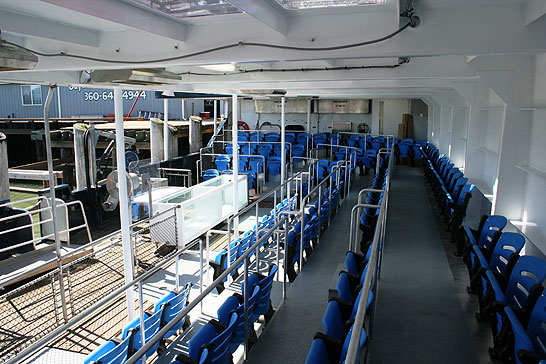
Stadium seating and catch tank..
Photo credit: 56degreesnorth
Imagine my excitement then, when last month I got an invitation to tour
the Aleutian Ballad, a boat featured prominently on the show, and a
legend in its own right. First of all, just to tour a crab boat from
this show for me is an incomprehensible treat. But, even among crab
boats, this is not just any boat. This is the first boat in documented
history to capture a rogue wave on video, and this amazing moment came
on none other than the first season of Deadliest Catch. When I think
back to any visual image I have of things I've seen on TV related to
the high seas, that rogue wave captured on video is seared in my memory
at the very top of the list. My mind can replay it almost perfectly.
The Aleutian Ballad, built in the mid-eighties, is no stranger to this
kind of species of spectacular incident. In 1991, a day that has become
known as Black Sunday throughout the Alaskan fishing industry brought
a devastating storm to the Bering Sea, pushing up waves of over 60 feet.
At the time, the ship was known as the Shannon Marie, and its captain,
Vance Jones, became so concerned with the danger of the worsening conditions
that he ordered all of his crew into survival suits, and called for
them to abandon ship. All of the crew were eventually rescued unharmed
by another boat. Two days later when seas became calm again, the Shannon
Marie was found intact, floating sedately in placid waters. An engineer
was flown to her by helicopter, and piloted the boat back to Dutch Harbor,
the vessel not much worse for the experience.
So then, walking down the gangway of Shilshole Marina in the Ballard
area of Seattle, I was nearly coming unglued with excitement. Here I
was, about to be boarding on this very boat, and eventually, unbeknownst
to me, I would be standing on the very spot on the bridge where the
rogue wave video had been shot. Unbelievable.
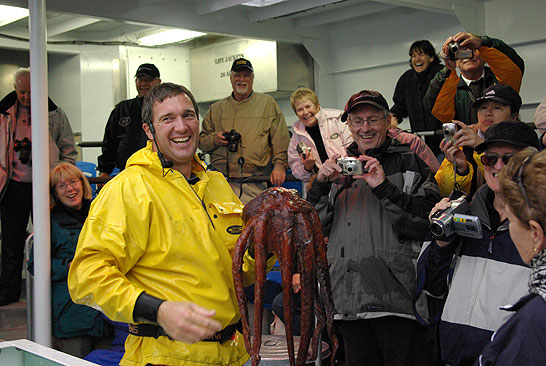
An octopus awaits its introduction to a waiting delegation of greeters.
Photo credit: 56degreesnorth
My excellent tour of the ship was given by its current captain, Dave
Lethin, who with 35 years of fishing experience, has fished the Bering
Sea since 1992. An Oregon State University graduate, he explained that
had his heart set on fishing since he was a small boy, and never wanted
to do anything else. His enthusiasm was heartfelt and contagious. The
$2.5 million conversion of the Aleutian Ballad from full time fishing
vessel to tour boat started with his desire to share his excitement
for fishing and the ocean with the world. The popularity of the Deadliest
Catch series gave him exactly that opportunity.
"I want people to experience exactly what we experience, and to
become totally engaged in something they'll never see again," he
says.
Concerning the retrofit, Dave smiles, "This is the happiest boat
in the world. She's pretty, and she knows she's never going back out
to get beat up again."
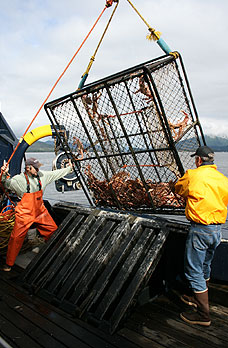
Hauling up a crab pot.
Photo credit: 56degreesnorth |
The tour takes place in Ketchikan, Alaska, and lasts
about 3 ½ hours, covering several miles of inland waterway. The
Aleutian Ballad has been fitted with enough stadium-style seating to
accommodate 104 passengers, which offer close-up views of the work happening
on-deck and great views of the scenery passing along outside the boat.
The evening before the tour, the crew sets a long line, crab pots, and
a shrimp pot, and then hauls them up onto the deck right before your
very eyes, as you sit watching from above. These 700 pound cumbersome
contraptions reveal all manner of creatures from the deep: King crab,
dogfish, octopus, box crab, rock fish, spot prawns, skate, snow crab,
rat fish, or grey cod, just to name a few.
As Dave explains, "On this boat, passengers get a feel for the
fascination we get to experience every time we pull up a crab pot."
The procured sea life is then placed into a massive glass tank in front
of you, and believe it or not, your participation with the beasties
is actually encouraged: If you want a picture of you with the octopus
or rat fish that ended up in that tank, just ask, one of the crew will
almost certainly be happy to hand it over to you, provided the creature
is relatively safe to handle. Wild. The catch is then turned back into
the ocean to relay their fantastic above-water experiences to their
waiting pals below.
You can also expect to see all kinds of amazing regional sights on the
other side of the rail: Native Indian fishermen hauling up thousands
of salmon in their seine nets, bald eagles along the shorelines, and
porpoises swimming nearby the boat. Humpback and grey whales are often
sighted, and killer whale pods have been seen as thick as 40 strong.
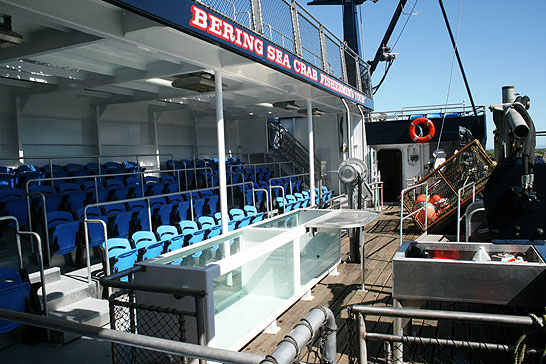
The iconic Aleutian Ballad seating and deck.
Photo credit: 56degreesnorth
The deckhands are all Bering Sea veterans, and in addition to their
duties of hauling up fish and crab on the deck for you, they also make
it a point to share their personal experiences and fishing stories from
their many years spent on the high seas. If you like, you can also have
a look around much of the rest of the ship, and there is even some bridge
time available after the tour is over. You too can stand in the very
spot the cameraman was shooting when the rogue wave swept over the vessel
in 2005. I did, it was raaaaaad.
I can tell you from personal experience that when you
talk to Dave and his crew about fishing it is clear that they are somewhere
else. They are standing right in front of you talking, sure, but it's
not so much that they're explaining the technicalities of boats and
netting and such… they sort of look off into the distance and relay
to you a tale that is being whispered into their ear at that very moment,
spoken by their own memories and experiences. As you absorb the impact
of their words, you suddenly find yourself a part of that narrative,
and the feeling is unforgettable.
You become lost in that ocean somewhere, hauling up the mysteries of
the deep.
For more information:
www.56degreesnorth.com
|












